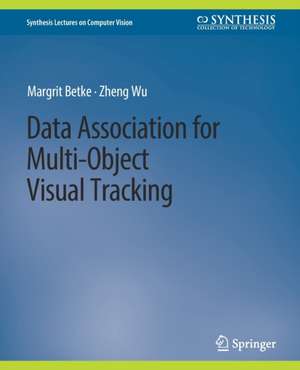Data Association for Multi-Object Visual Tracking: Synthesis Lectures on Computer Vision
Autor Margrit Betke, Zheng Wuen Limba Engleză Paperback – 11 oct 2016
Data association in the most general sense is the process of matching information about newly observed objects with information that was previously observed about them. This information may be about their identities, positions, or trajectories. Algorithms for data association search for matches that optimize certain match criteria and are subject to physical conditions. They can therefore be formulated as solving a "constrained optimization problem"—the problem of optimizing an objective function of some variables in the presence of constraints on these variables. As such, data association methods have a strong mathematical grounding and are valuable general tools for computer vision researchers.
This book serves as a tutorial on data association methods, intended for both students and experts in computer vision. We describe the basic research problems, review the current state of the art, and present some recently developed approaches. The book covers multi-object tracking in two and three dimensions. We consider two imaging scenarios involving either single cameras or multiple cameras with overlapping fields of view, and requiring across-time and across-view data association methods. In addition to methods that match new measurements to already established tracks, we describe methods that match trajectory segments, also called tracklets. The book presents a principled application of data association to solve two interesting tasks: first, analyzing the movements of groups of free-flying animals and second, reconstructing the movements of groups of pedestrians. We conclude by discussing exciting directions for future research.
Din seria Synthesis Lectures on Computer Vision
- 20%
 Preț: 353.28 lei
Preț: 353.28 lei - 20%
 Preț: 254.47 lei
Preț: 254.47 lei - 20%
 Preț: 273.49 lei
Preț: 273.49 lei - 20%
 Preț: 273.49 lei
Preț: 273.49 lei - 20%
 Preț: 277.60 lei
Preț: 277.60 lei - 20%
 Preț: 147.74 lei
Preț: 147.74 lei - 20%
 Preț: 269.20 lei
Preț: 269.20 lei - 20%
 Preț: 224.00 lei
Preț: 224.00 lei - 20%
 Preț: 331.74 lei
Preț: 331.74 lei - 20%
 Preț: 225.67 lei
Preț: 225.67 lei - 20%
 Preț: 225.15 lei
Preț: 225.15 lei - 20%
 Preț: 352.78 lei
Preț: 352.78 lei - 20%
 Preț: 354.92 lei
Preț: 354.92 lei - 20%
 Preț: 297.49 lei
Preț: 297.49 lei - 20%
 Preț: 177.47 lei
Preț: 177.47 lei - 20%
 Preț: 356.73 lei
Preț: 356.73 lei - 20%
 Preț: 294.54 lei
Preț: 294.54 lei - 20%
 Preț: 415.95 lei
Preț: 415.95 lei - 20%
 Preț: 353.43 lei
Preț: 353.43 lei - 20%
 Preț: 329.76 lei
Preț: 329.76 lei - 20%
 Preț: 383.57 lei
Preț: 383.57 lei - 20%
 Preț: 329.26 lei
Preț: 329.26 lei - 20%
 Preț: 222.50 lei
Preț: 222.50 lei - 20%
 Preț: 358.04 lei
Preț: 358.04 lei - 20%
 Preț: 240.56 lei
Preț: 240.56 lei - 20%
 Preț: 331.36 lei
Preț: 331.36 lei
Preț: 224.50 lei
Preț vechi: 280.62 lei
-20% Nou
Puncte Express: 337
Preț estimativ în valută:
42.96€ • 44.60$ • 35.82£
42.96€ • 44.60$ • 35.82£
Carte tipărită la comandă
Livrare economică 25 martie-08 aprilie
Preluare comenzi: 021 569.72.76
Specificații
ISBN-13: 9783031006883
ISBN-10: 3031006887
Ilustrații: IX, 110 p.
Dimensiuni: 191 x 235 mm
Greutate: 0.23 kg
Editura: Springer International Publishing
Colecția Springer
Seria Synthesis Lectures on Computer Vision
Locul publicării:Cham, Switzerland
ISBN-10: 3031006887
Ilustrații: IX, 110 p.
Dimensiuni: 191 x 235 mm
Greutate: 0.23 kg
Editura: Springer International Publishing
Colecția Springer
Seria Synthesis Lectures on Computer Vision
Locul publicării:Cham, Switzerland
Cuprins
Preface.- An Introduction to Data Association in Computer Vision.- Classic Sequential Data Association Approaches.- Classic Batch Data Association Approaches.- Evaluation Criteria.- Tracking with Multiple Cameras.- The Tracklet Linking Approach.- Advanced Techniques for Data Association.- Application to Animal Group Tracking in 3D.- Benchmarks for Human Tracking.- Concluding Remarks.- Bibliography.- Authors' Biographies .
Notă biografică
Margrit Betke is a Professor of Computer Science at Boston University, where she co-leads the Image and Video Computing Research Group. She earned her Ph.D. degree in Computer Science and Electrical Engineering at the Massachusetts Institute of Technology in 1995. She conducts research in computer vision, in particular, the development of methods for detection, segmentation, registration, and tracking of objects invisible-light, infrared, and x-ray image data. She has worked on gesture, vehicle, and animal tracking, video-based human-computer interfaces, statistical object recognition, and medical imaging analysis. Prof. Betke has co-invented the ""Camera Mouse,"" an assistive technology used worldwide by children and adults with severe motion impairments. She co-developed the first patented algorithms for detecting and measuring pulmonary nodule growth in computed tomography. She recently led a six-year research program to develop intelligent tracking systems that reason about group behavior of people, bats, birds, and cells. She has published over 140 original research papers.Zheng Wu is a Senior Computer Vision Engineer at The Mathworks, Inc., in Natick, Massachusetts, which is the producer of the widely used computing environment MATLAB. Before joining Mathworks, Dr. Wu was a postdoctoral associate in the Department of Computer Science at Boston University, where he earned his Ph.D. degree in 2012. He was a member of the Image and Video Computing research group at Boston University, working with Profs. Margrit Betke and Stan Sclaroff and their team of students. Dr. Wus general research interests include computer vision, machine learning, and combinatorial algorithms. In his work, he has focused on object segmentation, detection, and tracking, and has published over 20 original papers on these topics.
